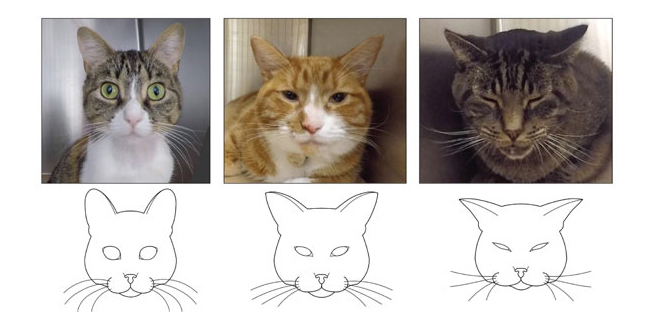New feline pain scale interprets pain from cats’ facial expressions

(Images of cats in which pain was absent, moderately present, or markedly present)
As a species, cats are pretty stoic, which makes diagnosing their pain notoriously difficult. A survey of veterinary technicians reported that only 8.1% of veterinary practices used a pain scoring system, yet 80.3% agreed it was a useful clinical tool.
There are a number of pain scoring scales specifically developed for measuring pain in cats, but only two were validated for clinical use—the UNESP-Botucatu Multidimensional Composite Pain Scale and the Glasgow Composite Measure Pain Scale.
Until now.
Because there’s a new pain scale in town: the Feline Grimace Scale (FGS), which interprets changes in facial expression, and could help provide practitioners—and possibly pet owners—with additional clues.
Plus, it’s validated.
Researchers at the University of Montreal (UM) performed an observational, case-control study of 31 client-owned cats in pain and 20 control cats who were not in pain in order to develop the scale.
The cats were video-recorded undisturbed in their cages. Researchers performed the assessment of the subjects’ facial expressions using screenshots from video files. Two observers independently compared images of the two groups to identify differences in facial expressions.
The researchers categorized, tested, and scored five facial action units indicative of pain in cats:
- Ear position: Ears facing forward, ears slightly pulled apart, or ears flattened and rotated outward
- Orbital tightening: Eyes opened, eyes partially opened, or eyes squinted
- Muzzle tension: Muzzle relaxed (round), muzzle mildly tense, or muzzle tense (elliptical)
- Whisker position: Whiskers loose and curved, whiskers slightly curved or straight, or whiskers straight and moving forward
- Head position: Head above the shoulder line, head aligned with the shoulder line, or head below the shoulder line or tilted
Each facial action unit gets a score of 0, 1, or 2.
A score of 0 means absence of the facial action unit, 1 is moderate appearance or uncertainty, and 2 is obvious appearance. A total score of 4 or more means the cat is in pain and needs analgesia. The maximum total score is 10.
NEWStat reached out to study coauthors Paulo Steagall, DVM, MSc, PhD, ACVAA(D), associate professor of veterinary anesthesia and analgesia at UM, and Maria Marina Evangelista, a PhD candidate at UM, to find out more.
“The FGS is a simple, practical, and reliable tool that has gone thorough scientific validation,” they told NEWStat via email. “Original validation was performed using image assessment, but a recent study has also shown its clinical applicability using real-time assessment.” (The study is under review and awaits publication.)
“[The FGS ] uses changes in facial expressions for acute pain assessment in cats, taking [into] consideration the clinical context.” They stress that it’s not just about looking at a still image—pain assessment is based on observation and scoring of those five facial action units.
To date, the FGS has been validated mostly for use by veterinarians, but Steagall and Evangelista say they’re currently testing its reliability when applied by other veterinary care professionals.
How about cat owners?
“It might be something useful for owners but we are still working on it.”
Photo credit: Dr. Paulo Steagall



